This week the United States celebrates Thanksgiving, a holiday in honor of families and friendship. For the most part, we lay aside our differences and grievances, and give thanks for what we have. The poor, aged, and lonely are not forgotten. Community soup kitchens are filled with volunteers, and many are turned away because of the sheer volume who want to serve their less fortunate brethren.
This annual North American feast is reminiscent of the British Christmas dinners celebrated in Jane Austen’s day. In Emma, Mr Elton states:
This is quite the season indeed for friendly meetings. At Christmas, everybody invites their friends about them, and people think little of even the worst weather.”
If we substitute Christmas for Thanksgiving, Austen’s phrase applies just as well. Foods offered on the Georgian Christmas table and Colonial thanksgiving tables in the U.S. and Canada have been remarkably similar from the 17th century on: Soup, cheese, nuts, turkey, goose, duck, mashed potato, yams, fresh cranberries, dried fruits, pumpkin and mince pies.
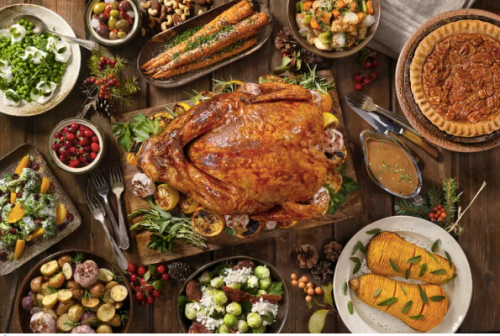
Image of traditional Thanksgiving foods. iStock image, LauriPatterson.
We North Americans have our British ancestors to thank for this tradition, so closely tied to these countries’ respective fall harvests. Earlier ripening explains why Canada’s Thanksgiving falls on the second Monday of October, almost two months before its southern neighbor, the US, celebrates this event.
Canadian Thanksgiving:
One can only envision the reaction of explorer Martin Frobisher and his men when, in three voyages to Canada to find a northwest passage to Asia, they encountered the immensity, richness, and diversity of flora and fauna, and countless miles of almost untouched forests, lakes, and fields populated by an abundance of wildlife. These natural riches must have overwhelmed their senses, prompting them to give thanks in a tradition still celebrated today. The reality was less than elaborate:
In 1578, … privateer and mariner Sir Martin Frobisher was the first European to celebrate “Thanksgiving” with his crew. The meal was decidedly less glamorous than today’s feasts: mostly salt beef, biscuits and mushy peas. The locale, too, was less inviting. Frobisher and his men celebrated in current-day Nunavut, likely aboard one of the 15 ships that had set sail to discover a northwest passage to Asia’s trading areas. – A Short History of Thanksgiving in Canada, Ottawa Citizen
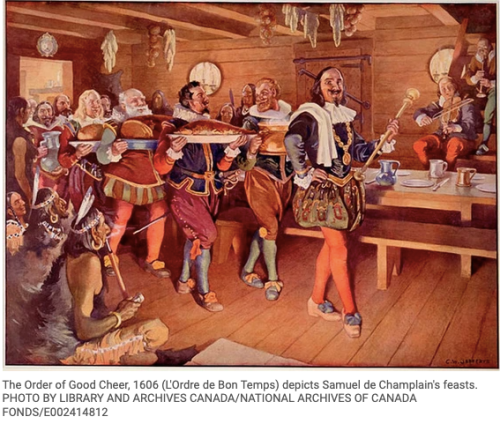
Explorer Samuel de Champlain organized a thanksgiving celebration in the early 17th century which is more reminiscent of today’s ceremonies than Frobisher’s. To prevent scurvy, Champlain introduced a variety of foods that included fresh vegetables and fruits high in vitamin C, such as cranberries. Since the 18th century, Nova Scotia’s Thanksgiving meals have resembled today’s variety of foods. But this is not the full story. Without indigenous Indians, neither the Canadian explorers nor the pilgrims would have survived long enough to present a meal of any great variety.
U.S. Thanksgiving:
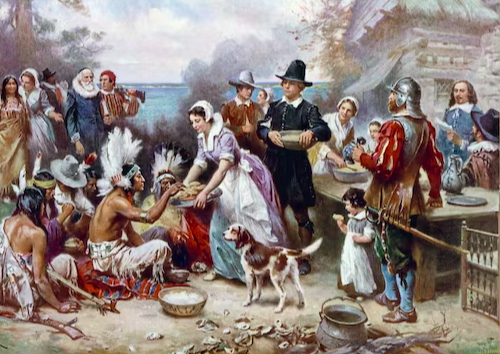
Romantic version of the first Thanksgiving in the U.S. Plymouth Rock Foundation.
In contrast to the happy scene depicted in the storybook image above, settlers and indigenous warriors experienced devastating losses from natural causes – the settlers from starvation and the tribes from the loss of as much as 50 to 90 percent of their population to the epidemics the Europeans brought with them. The pilgrims and Wampanoags joined forces to strengthen their numbers and to fight off possible attacks from other Indian tribes. And so the Wampanoags taught settlers to plant corn and other vegetables and to use herring for fertilizer. Under their tutelage, the pilgrims learned to fish for cod and bass, build housing with the materials at hand, and trade and barter for products they could not produce.
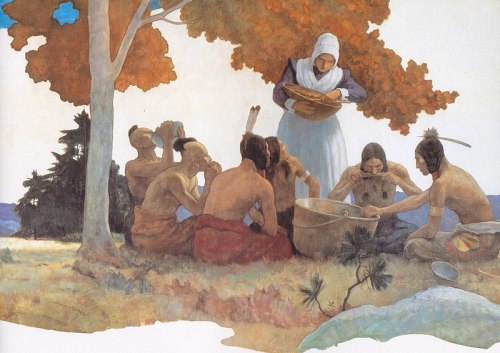
Detail of an NC Wyeth painting, Wikimedia Commons
After the bountiful result of their hard labor, the pilgrims commemorated their success with a series of feasts that featured the riches of their fall harvest. The chief of the Wampanoags, Massasoit, attended the event for three days with 90 men. They brought five deer, which were roasted, and played games in celebration. According to an article in the National Endowment for the Humanities entitled Who Were the Pilgrims Who Celebrated the First Thanksgiving? | The National Endowment for the Humanities this was the true first American Thanksgiving.
Interestingly, in 1862 President Lincoln declared the turkey to be the official meat for the Thanksgiving dinner table. Before this time, there was no consensus. U.S. dinner tables had featured venison, ham, pheasant, duck, oysters, and other choices preferred regionally, such as bison. Personally, I like turkey once a year. At Christmas, I prefer ham.
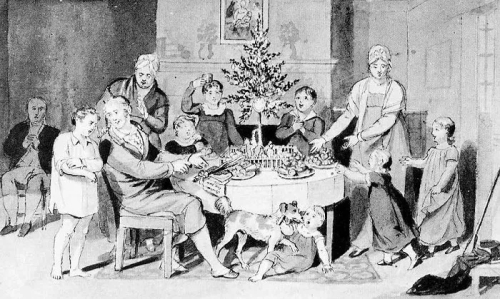
Festive 19th century Christmas goodies for a family. Image: British Food and Travel
British Christmas Dinner:
When one examines the traditional Traditional Christmas dinner menu featured in this BBC Good Food website, one recognizes how close the three nations still are in their traditional celebratory food offerings. Oh, variations have crept in. Local foods are offered in abundance (in Maryland crab cakes and seafood recipes are heavily featured, and Tex Mex recipes are also making an appearance, especially at the appetizer and dessert tables.) But overall, we U.S. Americans are staying with the traditional holiday feast on the 4th Thursday in November.
Author Syrie James’s Jane Austen quote is apropos for both holiday feasts:
After Jane Austen’s Christmas guests had departed in January 1807, Jane wrote to her sister, Cassandra, “I shall be left to the comfortable disposal of my time, to ease of mind from the torments of rice puddings and apple dumplings, and probably to regret that I did not take more pains to please them all.”







